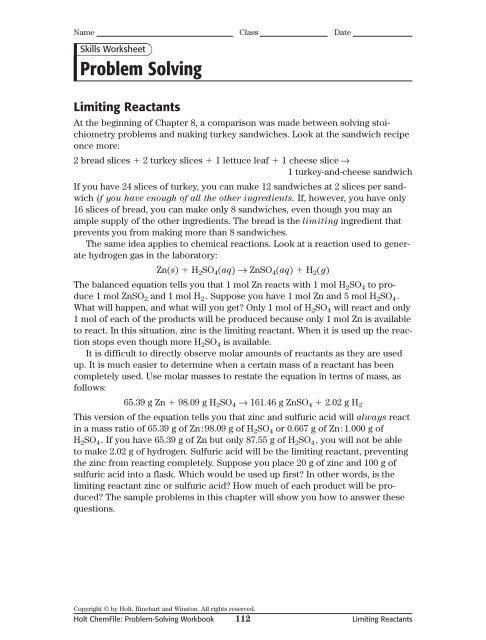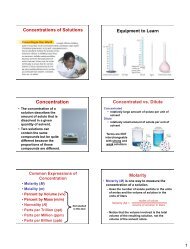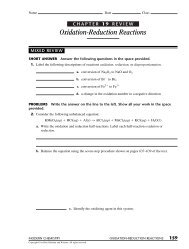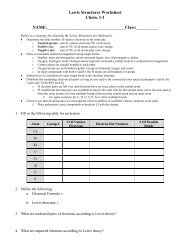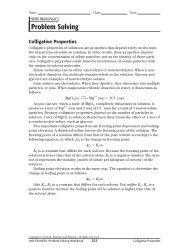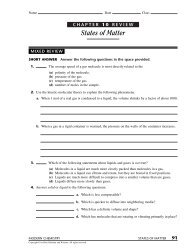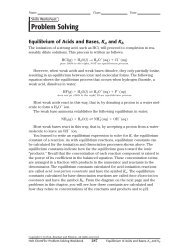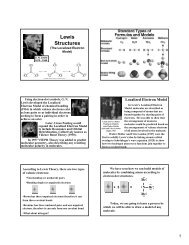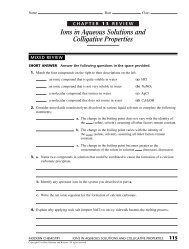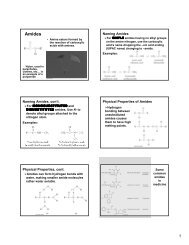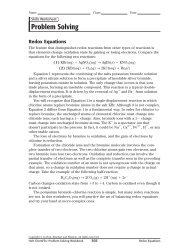Limiting Reactant
Limiting Reactant
Limiting Reactant
- No tags were found...
Create successful ePaper yourself
Turn your PDF publications into a flip-book with our unique Google optimized e-Paper software.
Name Class DateProblem Solving continuedCOMPUTEThe computation shows that more HCl (6.3 mol) is available than is needed (5.6mol) to react with the 2.8 mol Ca(OH) 2 available. Therefore, HCl is present inexcess, making Ca(OH) 2 the limiting reactant.EVALUATEIs the answer reasonable?Yes; you can see that 6.3 mol HCl is more than is needed to react with 2.8 molCa(OH) 2 .Practicemole ratiogiven 2 mol HClmol Ca(OH) 2 mol HCl needed1 mol Ca(OH) 22.8 mol Ca(OH) 2 2 mol HCl1 mol Ca(OH) 2 5.6 mol HCl needed1. Aluminum oxidizes according to the following equation:4Al 3O 2 → 2Al 2 O 3Powdered Al (0.048 mol) is placed into a container containing 0.030 mol O 2 .What is the limiting reactant? ans: O 2Copyright © by Holt, Rinehart and Winston. All rights reserved.Holt ChemFile: Problem-Solving Workbook 115 <strong>Limiting</strong> <strong>Reactant</strong>s
Name Class DateProblem Solving continuedOnly 0.0121 mol Cl 2 is available. For all of the KBr to react, 0.0136 mol Cl 2 isneeded. Therefore, Cl 2 is the limiting reactant.0.0121 mol Cl 2 1 mol Br 2 159.80 g Br 2 1.93 g Br 21 mol Cl 2 1 mol Br 2EVALUATEIs the determination of limiting reactant reasonable?Yes; the mass of 2 mol KBr is 238 g and the mass of 1 mol Cl 2 is about 71 g, sothey react in roughly a 3:1 ratio by mass. 3.2 g KBr would require about 1 g ofCl 2 , but only 0.855 g is available.Are the units and significant figures of the mass of Br 2 correct?The number of significant figures is correct because the mass of Cl 2 was given tothree significant figures. Units cancel to give grams of Br 2 .Practice1. A process by which zirconium metal can be produced from the mineral zirconium(IV)orthosilicate, ZrSiO 4 , starts by reacting it with chlorine gas to formzirconium(IV) chloride.ZrSiO 4 2Cl 2 → ZrCl 4 SiO 2 O 2What mass of ZrCl 4 can be produced if 862 g of ZrSiO 4 and 950. g of Cl 2 areavailable? You must first determine the limiting reactant. ans: ZrSiO 4 , 1.10 10 3 g ZrCl 4Copyright © by Holt, Rinehart and Winston. All rights reserved.Holt ChemFile: Problem-Solving Workbook 118 <strong>Limiting</strong> <strong>Reactant</strong>s
Name Class DateProblem Solving continuedAdditional Problems1. Heating zinc sulfide in the presence of oxygen yields the following:ZnS O 2 → ZnO SO 2If 1.72 mol of ZnS is heated in the presence of 3.04 mol of O 2 , which reactantwill be used up? Balance the equation first.2. Use the following equation for the oxidation of aluminum in the followingproblems.4Al 3O 2 → 2Al 2 O 3a. Which reactant is limiting if 0.32 mol Al and 0.26 mol O 2 are available?b. How many moles of Al 2 O 3 are formed from the reaction of 6.38 10 3 molof O 2 and 9.15 10 3 mol of Al?c. If 3.17 g of Al and 2.55 g of O 2 are available, which reactant is limiting?3. In the production of copper from ore containing copper(II) sulfide, the ore isfirst roasted to change it to the oxide according to the following equation:2CuS 3O 2 → 2CuO 2SO 2a. If 100 g of CuS and 56 g of O 2 are available, which reactant is limiting?b. What mass of CuO can be formed from the reaction of 18.7 g of CuS and12.0 g of O 2 ?4. A reaction such as the one shown here is often used to demonstrate a singlereplacement reaction.3CuSO 4 (aq) 2Fe(s) → 3Cu(s) Fe 2 (SO 4 ) 3 (aq)If you place 0.092 mol of iron filings in a solution containing 0.158 mol ofCuSO 4 , what is the limiting reactant? How many moles of Cu will be formed?5. In the reaction BaCO 3 2HNO 3 → Ba(NO 3 ) 2 CO 2 H 2 O, what mass ofBa(NO 3 ) 2 can be formed by combining 55 g BaCO 3 and 26 g HNO 3 ?6. Bromine displaces iodine in magnesium iodide by the following process:MgI 2 Br 2 → MgBr 2 I 2a. Which is the excess reactant when 560 g of MgI 2 and 360 g of Br 2 react, andwhat mass remains?b. What mass of I 2 is formed in the same process?7. Nickel displaces silver from silver nitrate in solution according to the followingequation:2AgNO 3 Ni → 2Ag Ni(NO 3 ) 2a. If you have 22.9 g of Ni and 112 g of AgNO 3 , which reactant is in excess?b. What mass of nickel(II) nitrate would be produced given the quantitiesabove?Copyright © by Holt, Rinehart and Winston. All rights reserved.Holt ChemFile: Problem-Solving Workbook 119 <strong>Limiting</strong> <strong>Reactant</strong>s
Name Class DateProblem Solving continued8. Carbon disulfide, CS 2 , is an important industrial substance. Its fumes canburn explosively in air to form sulfur dioxide and carbon dioxide.CS 2 (g) O 2 (g) → SO 2 (g) CO 2 (g)If 1.60 mol of CS 2 burns with 5.60 mol of O 2 , how many moles of the excessreactant will still be present when the reaction is over?9. Although poisonous, mercury compounds were once used to kill bacteria inwounds and on the skin. One was called “ammoniated mercury” and is madefrom mercury(II) chloride according to the following equation:HgCl 2 (aq) 2NH 3 (aq) → Hg(NH 2 )Cl(s) NH 4 Cl(aq)a. What mass of Hg(NH 2 )Cl could be produced from 0.91 g of HgCl 2 assumingplenty of ammonia is available?b. What mass of Hg(NH 2 )Cl could be produced from 0.91 g of HgCl 2 and 0.15 gof NH 3 in solution?10. Aluminum chips are sometimes added to sodium hydroxide-based draincleaners because they react to generate hydrogen gas which bubbles andhelps loosen material in the drain. The equation follows.Al(s) NaOH(aq) H 2 O(l) → NaAlO 2 (aq) H 2 (g)a. Balance the equation.b. How many moles of H 2 can be generated from 0.57 mol Al and 0.37 molNaOH in excess water?c. Which reactant should be limiting in order for the mixture to be mosteffective as a drain cleaner? Explain your choice.11. Copper is changed to copper(II) ions by nitric acid according to the followingequation:4HNO 3 Cu → Cu(NO 3 ) 2 2NO 2 2H 2 Oa. How many moles each of HNO 3 and Cu must react in order to produce0.0845 mol of NO 2 ?b. If 5.94 g of Cu and 23.23 g of HNO 3 are combined, which reactant is inexcess?12. One industrial process for producing nitric acid begins with the followingreaction:4NH 3 5O 2 → 4NO 6H 2 Oa. If 2.90 mol NH 3 and 3.75 mol O 2 are available, how many moles of eachproduct are formed?b. Which reactant is limiting if 4.20 10 4 g of NH 3 and 1.31 10 5 g of O 2 areavailable?c. What mass of NO is formed in the reaction of 869 kg of NH 3 and 2480 kgO 2 ?Copyright © by Holt, Rinehart and Winston. All rights reserved.Holt ChemFile: Problem-Solving Workbook 120 <strong>Limiting</strong> <strong>Reactant</strong>s


